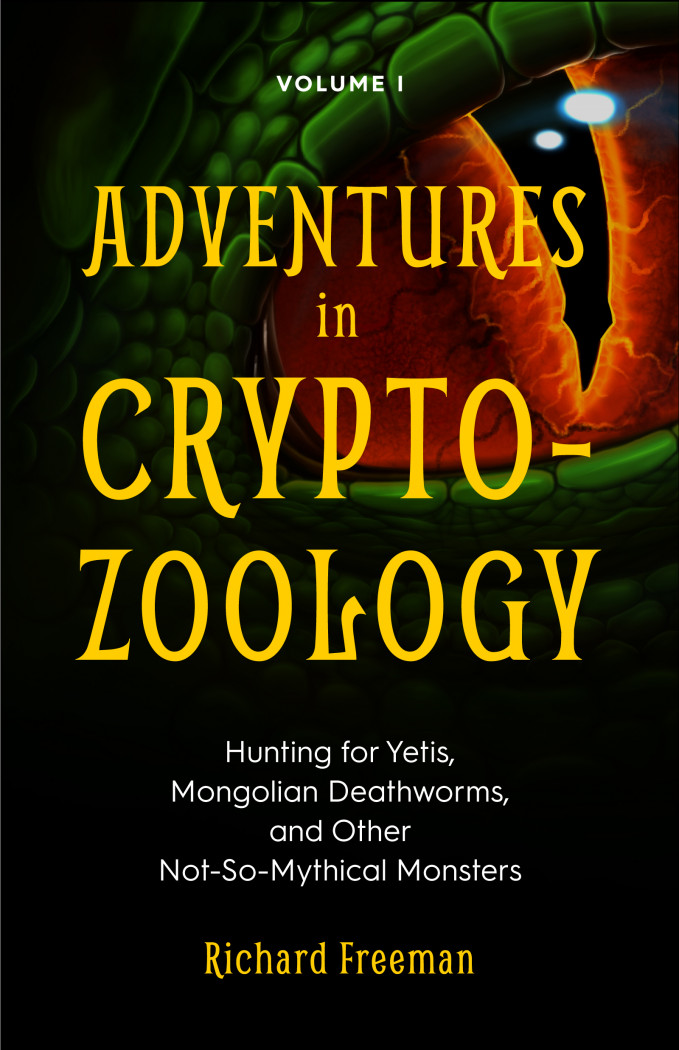Just recently, I received a review copy of a great new book from full-time cryptozoologist/writer/researcher Richard Freeman. Rich, who lives in the U.K., has traveled around the world in search of lake-monsters, unknown apes, flying monsters and more. His new book is titled Adventures in Cryptozoology, while the subtitle is: Hunting for Yetis, Mongolian Deathworms, and Other Not-So-Mythical Monsters. Normally, when I get a copy of a new book from a publisher, I review it here at Mysterious Universe. But, I thought with Rich’s latest release I would do something a bit different. Namely, to interview Rich about his new book, rather than just review it. And that’s exactly what I’ve done. Since the Q&A is a long one, I have split it into two features. And, with that all said, here are the opening salvos of questions on the matter of Richard Freeman’s investigations into the world of monsters.
Q: What can you tell us about your new book?
A.: Well, the book was not actually my idea. Mango Publishing approached me, because of my work and expeditions, to write a book that would be an introduction to cryptozoology. It’s a big subject, and the manuscript was so long that the publishers decided to split it into two volumes. The first volume is out now and the second volume is due out at the end of 2019 or early 2020.
Q: So, what does volume one cover?
A: It starts with an explanation of what cryptozoology actually is and what it covers. I start with a history of cryptozoology and the creatures that were once thought of as “monsters,” but that turned out to be real animals. Take, for instance, the giant squid, a creature that can reach sixty feet long. One French biologist, Pierre Denys de Montfort, in the late 18th century, theorized the existence of gigantic squid based on sightings from whalers. One such man, Ben Johnson, told of a monstrous tentacle found in the mouth of a sperm whale they had killed. The tentacle was 35 feet long and had been severed at both ends. De Montfort reckoned another 10-20 feet of it had been lost. It was as thick as a mast with suckers the size of hats.
Q: And there are other examples?
A: Yes, another man, Reynolds, told of seeing what he thought was a red sea serpent lying next to a whale they had killed. It was discovered to be a massive tentacle, 45 feet long with suckers as large as plates. On publishing his theories, de Montfort was met with instant hostility in France. Despite being closer to the truth than anyone had imagined, he became a pariah in scientific circles because of his theory. Out of work in scientific agencies, he retreated to the country and wrote books on bee-keeping and linguistics. Returning penniless to Paris, he scratched the most meager of livings identifying shells for naturalists and collectors. He became a wretched, ragged figure and finally a destitute alcoholic. He was found dead of starvation in 1820, a pitiful end for a man once associated with the most august scientific institutes in Paris. Pierre Denys de Montfort has been largely forgotten. After his death, de Montfort was proved correct when parts of gigantic squid began to fall into the hands of scientists. Danish zoologist Professor Johannes Japetus Smith Steenstrup published the first scientific description of the giant squid. We now know the giant squid (Architeuthis dux) exists. The point is the he was correct all along; this monster was real.
Q: You have other cases on record, too?
A: Yes, the list is long and ongoing. For years stories had circulated of a savage, hairy giant inhabiting the jungles of Central Africa. Natives called the creature the “pongo,” which was said to kidnap and rape women and tear branches from trees to beat elephants to death. Then in 1860 French zoologist Paul Belloni Du Chaillu discovered the lowland gorilla (Gorilla gorilla). Of course, the stories attached to it were local mythology, but the animal itself did exist. It was not until 1902 that it’s relative the mountain gorilla (Gorilla gorilla beringe) was proven to exist when German army officer Friedrich Robert von Beringe shot two specimens in what was then German Est Africa. Keep these stories in mind when we examine stories of other hairy giants in other mountain ranges later in the book. They are now dismissed as the gorilla once was.
Q: What else particularly intrigues you?
A: In the same forests that the lowland gorilla called home there were strange stories of a striped, donkey-like beast called the atti. Welsh explorer Henry Morton Stanley heard of this beast while in the Congo. Sometime later the British Governor of Uganda, Sir Harry Johnson, rescued some pygmies in the Congo who had been abducted by a showman. When he returned them home, the grateful pygmies showed Johnson the tracks of the atti. Johnson was expecting the animal to be a forest zebra, but instead he found cloven- hoofed spoor. He later obtained a skull and skin of one of the beasts. In 1901, English zoologist Philip Lutley Sclater identified it as a species of short neck giraffe naming it the Okapi (Okapia johnstoni). Another traveler’s tale was that of a dangerous dragon-like beast said to haunt several remote islands in an Indonesian archipelago. It was said that the Sultan of Sumbawa, a neighboring island in the chain, would banish wrongdoers, rivals and other undesirables on these islands to be devoured by the beasts. Pearl fisherman brought back hair raising stories of encounters with the monsters. The beasts were said to have razor sharp teeth and claws and a taste for human flesh.
Q: And it doesn’t end there, right?
A: In a story worthy of Edgar Rice-Burroughs, a western aviator crashed on one of the islands and found himself surrounded by “dragons.” With the curiosity of western science piqued, an expedition was led by the wonderfully named Governor of Flores, J.K.H van Setyn van Hensbroek, in 1912. He secured a specimen of what is now known as the Komodo dragon (Varanus komodoensis). Growing to over ten feet long and tipping the scales at 150lbs, the Komodo dragon is the largest known lizard and the largest venomous creature, producing a hemotoxin that acts as an anticoagulant in the blood of its victims. It kills with razor teeth and a venomous saliva, taking down deer, water buffalo, wild boar and even humans. The venom hinders the clotting of blood causing the victim to weaken through blood loss. Other creatures turn out to be species long thought extinct. On December 22nd, 1938 Marjorie Courtney-Latimer, the curator of a small museum on the South African coast, was examining the catch from a local trawler. She would often pick up specimens for the museum from the catch of fishermen. Among the catch that day was a five- foot -long blue fish with a formidable set of teeth. It had a strange, fan-like tail and fins that resembled stubby legs. Realizing that this was unlike any fish she had seen before Marjorie arranged for it to be transported back to the museum and put on ice. She then wrote to her friend Professor J.L.B Smith, an ichthyologist of great standing at Rhodes University College in Georgetown, including a drawing and description of the fish. The Professor did not receive the letter till 3rd January but when he read it he recorded his thoughts. “…a bomb seemed to burst in my brain and beyond that sketch and the paper of the letter I was looking at a series of fishy creature…fishes no longer here, fishes that had lived in the dim past ages gone, and of which only often fragmentary remains in rock are know.” On February 16th Professor Smith arrived at the museum to examine the remains and had his suspicions confirmed. What Marjorie had saved from the nets was a fish from an order thought extinct for 65 million years, the Crossopterygii or coelacanths. The fish was given the scientific name of Latimeria chalumnea but was known simply as the coelacanth in popular parlance.


